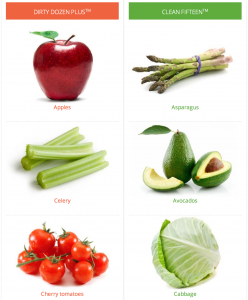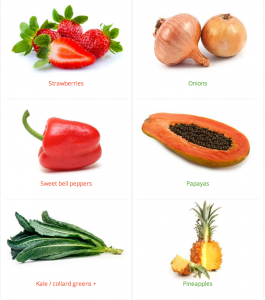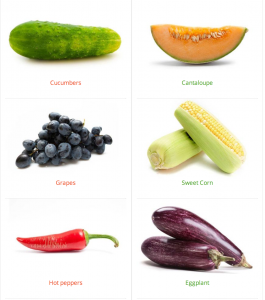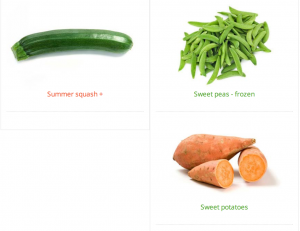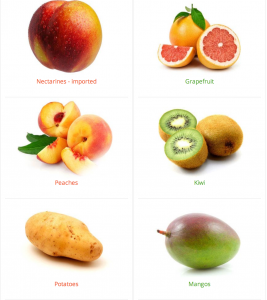Important information when purchasing food! Hormone disruptors are dangerous to your health.
Our species evolved in an environment where, for a hundred thousand years or so, the molecules we encountered were natural and our bodies were able to metabolize them. However, in the mid 1800s, chemists began synthesizing carbon-based molecules that our bodies don’t break down, and some of these stay in our bodies for years. Today there are countless new artificial molecules in our environment, from those that make our hair smell nice or our fingernails look pretty, to cleaners or pesticides.
When selecting produce, choose fruits and vegetables that have the least exposure to pesticides. Apples, celery, and tomatoes typically have more pesticide residue than, for example, cantaloupe, sweet corn, grapefruit, or sweet potatoes.
Environmental Working Group‘s 2013 Shopper’s Guide to Pesticides in Produce™
Eat fruits and vegetables!
The health benefits of a diet rich in fruits and vegetables outweigh the risks of pesticide exposure. Use EWG’s Shopper’s Guide to Pesticides™ to reduce your exposures as much as possible, but eating conventionally-grown produce is far better than not eating fruits and vegetables at all. The Shopper’s Guide to Pesticides in Produce™ will help you determine which fruits and vegetables have the most pesticide residues and are the most important to buy organic. You can lower your pesticide intake by avoiding the 12 most contaminated fruits and vegetables and choosing the least contaminated produce.
For the second year, we have expanded the Dirty Dozen™ with a Plus category to highlight two crops – domestically-grown summer squash and leafy greens, specifically kale and collards. These crops did not meet traditional Dirty Dozen™ criteria but were commonly contaminated with pesticides exceptionally toxic to the nervous system.
Though the Environmental Protection Agency has been restricting the uses of the most toxic pesticides, they are still detected on some foods. For example, green beans were on last year’s Plus list because they were often contaminated with two highly toxic organophosphates. Those pesticides are being withdrawn from agriculture. But leafy greens still show residues of organophosphates and other risky pesticides. That’s why they are on the Plus list for 2013.
Tests in 2008 found that some domestically-grown summer squash – zucchini and yellow crookneck squash — contained residues of harmful organochlorine pesticides that were phased out of agriculture in the 1970s and 1980s but that linger on some farm fields.
Genetically modified plants, or GMOs, are not often found in the produce section of grocery stores. Field corn, nearly all of which is produced with genetically modified seeds, is used to make tortillas, chips, corn syrup, animal feed and biofuels. Because it is not sold as a fresh vegetable, it is not included in EWG’s Shopper’s Guide to Pesticides in Produce. Nor is soy, another heavily GMO crop that makes its way into processed food.
The genetically modified crops likely to be found in produce aisles of American supermarkets are zucchini, Hawaiian papaya and some varieties of sweet corn. Most Hawaiian papaya is a GMO. Only a small fraction of zucchini and sweet corn are GMO. Since U.S. law does not require labeling of GMO produce, EWG advises people who want to avoid it to purchase the organically-grown versions of these items.
Dirty Dozen PlusTM Clean Fifteen TM Dirty Dozen PlusTM Clean Fifteen TM
